Transitional Flow on Model Propellers and Their Influence on Relative Rotative Efficiency
Abstract
:1. Introduction
2. Propeller Model and Model Tests
3. Numerical Methods
3.1. Numerical Models
3.2. Numerical Schemes
- Incompressible pressure-based solver.
- Pressure and velocity solved in a coupled manner.
- Second order discretisation for pressure gradient at face.
- QUICK scheme for all transport equations.
- Single Reference Frame for POT calculation in a steady mode.
- Sliding mesh grid interface for calculation in the behind condition in an unsteady mode.
3.3. Computational Domain and Mesh
3.4. Boundary Conditions
4. Results and Discussions
4.1. Convergence of the Solution
4.2. In Open Water Conditions
4.2.1. Paint Test vs. Predicted Near-Wall Flow
4.2.2. Flow Feature along Blade Sections
4.3. In Behind Condition
4.3.1. Paint Test Results and Predicted Streamlines
4.3.2. Flow Feature along Blade Sections
4.4. POW Characteristics at Two Rn Numbers
4.5. Influence on Performance Prediction
5. Conclusions
Author Contributions
Funding
Acknowledgments
Conflicts of Interest
Abbreviations
| ITTC | International Towing Tank Conference |
| POT | Propeller Open water Test |
| 2POT | Two Sets of Propeller Open Water Tests |
| POW | Propeller Open Water Characteristics |
| SPT | Self-Propulsion Test |
| LE | Leading Edge |
| TE | Trailing Edge |
| PS | Pressure Side |
| SS | Suction Side |
References
- Tamura, K.; Sasajima, T. Some Investigations on Propeller Open-Water Characteristics for Analysis of Self-Propulsion Factors; Mitsubishi Heavy Industries, Ltd.: Tokyo, Japan, 1977. [Google Scholar]
- Tsuda, T.; Konishi, S.; Asano, S.; Ogawa, K.; Hayasaki, K. Effect of propeller Reynolds number on self-propulsion performance. Jpn. Soc. Nav. Archit. Ocean Eng. 1978, 169, 127–136. [Google Scholar]
- Hasuike, N.; Okazaki, A.; Yamasaki, S.; Ando, J. Reynolds effect on Propulsive Performance of Marine Propeller Operating in wake flow. In Proceedings of the 16th NuTTS 2013, Mulheim, Germany, 2–4 September 2013. [Google Scholar]
- Hasuike, N.; Okazaki, M.; Okazaki, A. Flow characteristics around marine propellers in self-propulsion test condition. In Proceedings of the 19th NuTTS, St. Pierre d’Oleron, France, 3–4 October 2016. [Google Scholar]
- Hasuike, N.; Okazaki, M.; Okazaki, A.; Fujiyama, K. Scale effects of marine propellers in POT and self-propulsion test conditions. In Proceedings of the 5th International Symposium on Marine Propulsors, SMP’17, Espoo, Finland, 12–15 June 2017. [Google Scholar]
- Streckwall, H.; Lucke, T.; Bugalski, T.; Felicjancik, J.; Goedicke, T.; Greitsch, L.; Talay, A.; Alvar, M. Numerical Studies on Propellers in Open Water and behind Hulls aiming to support the Evaluation of Propulsion Tests. In Proceedings of the 19th NuTTS, St. Pierre d’Oleron, France, 3–4 October 2016. [Google Scholar]
- Helma, S. An Extrapolation Method Suitable for Scaling of Propellers of any Design. In Proceedings of the 4th International Symposium on Marine Propulsors, SMP’15, Austin, TX, USA, 1–4 June 2015. [Google Scholar]
- Lücke, T.; Streckwall, H. Experience with Small Blade Area Propeller Performance. In Proceedings of the 5th International Symposium on Marine Propulsors, SMP’17, Espoo, Finland, 12–15 June 2017. [Google Scholar]
- Heinke, H.J.; Hellwig-Rieck, K.; Lübke, L. Influence of the Reynolds Number on the Open Water Characteristics of Propellers with Short Chord Lengths. In Proceedings of the 6th International Symposium on Marine Propulsors, SMP’19, Rome, Italy, 17–21 May 2019. [Google Scholar]
- Bhattacharyya, A.; Neitzel, J.C.; Steen, S.; Abdel-Maksoud, M.; Krasilnikov, V. Influence of Flow Transition on Open and Ducted Propeller Characteristics. In Proceedings of the 4th International Symposium on Marine Propulsors, SMP’15, Austin, TX, USA, 1–4 June 2015. [Google Scholar]
- Bhattacharyya, A.; Krasilnikov, V.; Steen, S. A CFD-based scaling approach for ducted propellers. Ocean Eng. 2016, 123, 116–130. [Google Scholar] [CrossRef]
- Bhattacharyya, A.; Krasilnikov, V.; Steen, S. Scale effects on open water characteristics of a controllable pitch propeller working within different duct designs. Ocean Eng. 2016, 112, 226–242. [Google Scholar] [CrossRef]
- Sánchez-Caja, A.; González-Adalid, J.; Pérez-Sobrino, M.; Sipilä, T. Scale Effects on Tip Loaded Propeller Performance Using a RANSE Solver. Ocean Eng. 2014, 88, 607–617. [Google Scholar] [CrossRef]
- Shin, K.W.; Andersen, P. CFD Analysis of Scale Effects on Conventional and Tip-Modified Propellers. In Proceedings of the 5th International Symposium on Marine Propulsors, SMP’17, Espoo, Finland, 12–15 June 2017. [Google Scholar]
- Moran-Guerrero, A.; Gonzalez-Adalid, J.; Perez-Sobrino, M.; Gonzalez-Gutierrez, L. Open Water results comparison for three propellers with transition model, applying crossflow effect, and its comparison with experimental results. In Proceedings of the 5th International Symposium on Marine Propulsors, SMP’17, Espoo, Finland, 12–15 June 2017. [Google Scholar]
- Baltazar, J.; Rijpkema, D.; De Campos, J.F. On the use of the γ-Reθ transition model for the prediction of propeller performance at model-scale. In Proceedings of the 5th International Symposium on Marine Propulsors, SMP’17, Espoo, Finland, 12–15 June 2017. [Google Scholar]
- Gaggero, S.; Villa, D. Improving model scale propeller performance prediction using the k-kL-w transition model in OpenFOAM. Intl. Shipbuild. Prog. 2018, 65, 187–226. [Google Scholar] [CrossRef]
- Colonia, S.; Leble, V.; Steijl, R.; Barakos, G. Assessment and Calibration of the g-Equation Transition Model at Low Mach. AIAA J. 2017, 55, 1126–1139. [Google Scholar] [CrossRef]
- Lopes, R.; Eca, L.; Vaz, G. On the Decay of Free-stream Turbulence Predicted by Two-equation Eddy-viscosity Models. In Proceedings of the 20th NuTTS, Wageningen, The Netherlands, 1–3 October 2017. [Google Scholar]
- Moran-Guerrero, A.; Gonzalez-Gutierrez, L.M.; Oliva-Remola, A.; Diaz-Ojeda, H.R. On the influence of transition modeling and crossflow effects on open water propeller simulations. Ocean Eng. 2018, 156, 101–119. [Google Scholar] [CrossRef]
- Menter, F.R. Two-Equation Eddy-Viscosity Turbulence Models for Engineering Applications. AIAA J. 1994, 32, 1598–1605. [Google Scholar] [CrossRef]
- Menter, F.R.; Smirnov, P.E.; Liu, T.; Avancha, R. A one-equation local correlation-based transition model. Flow Turbul. Combust. 2015, 95, 583–619. [Google Scholar] [CrossRef]
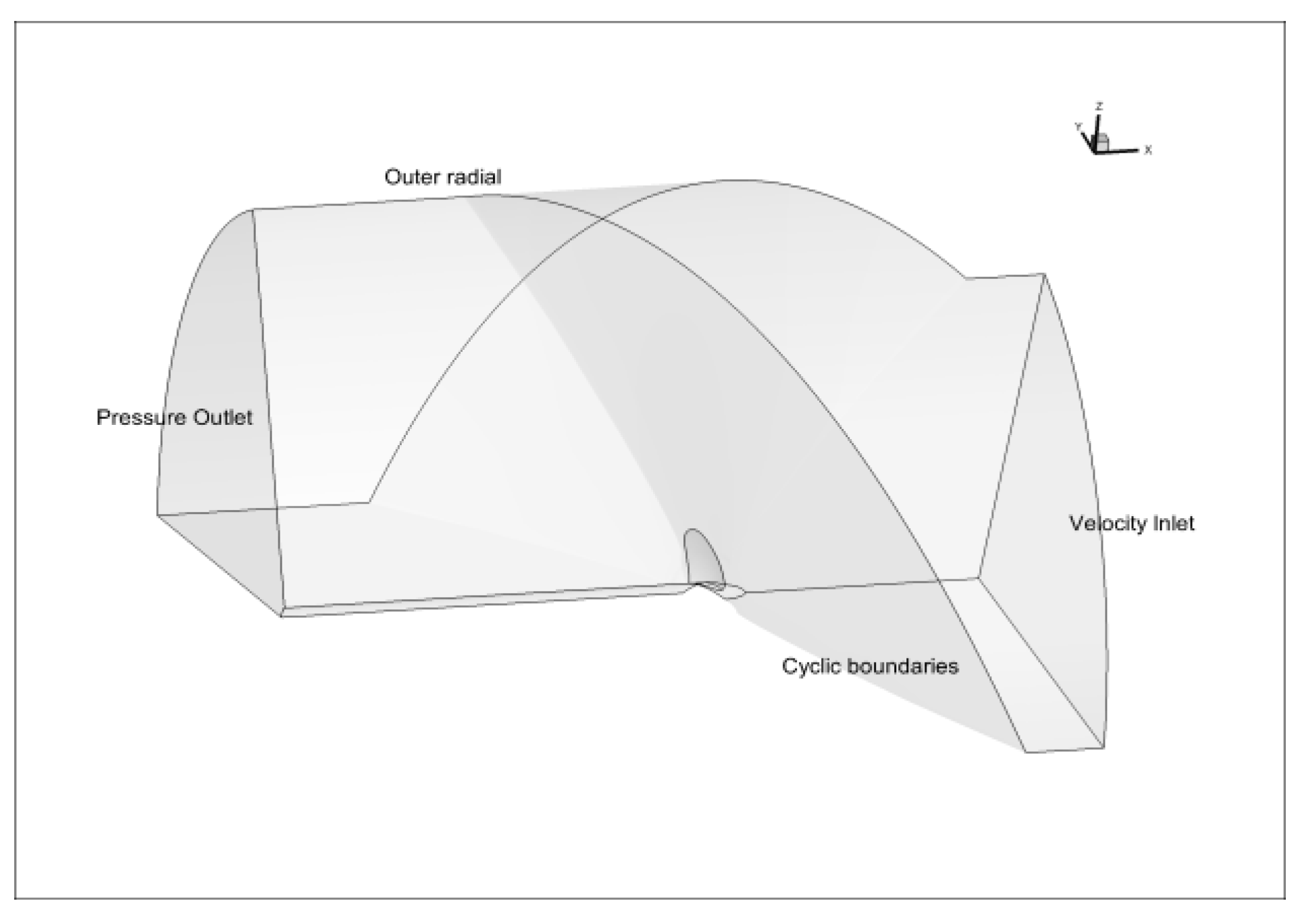


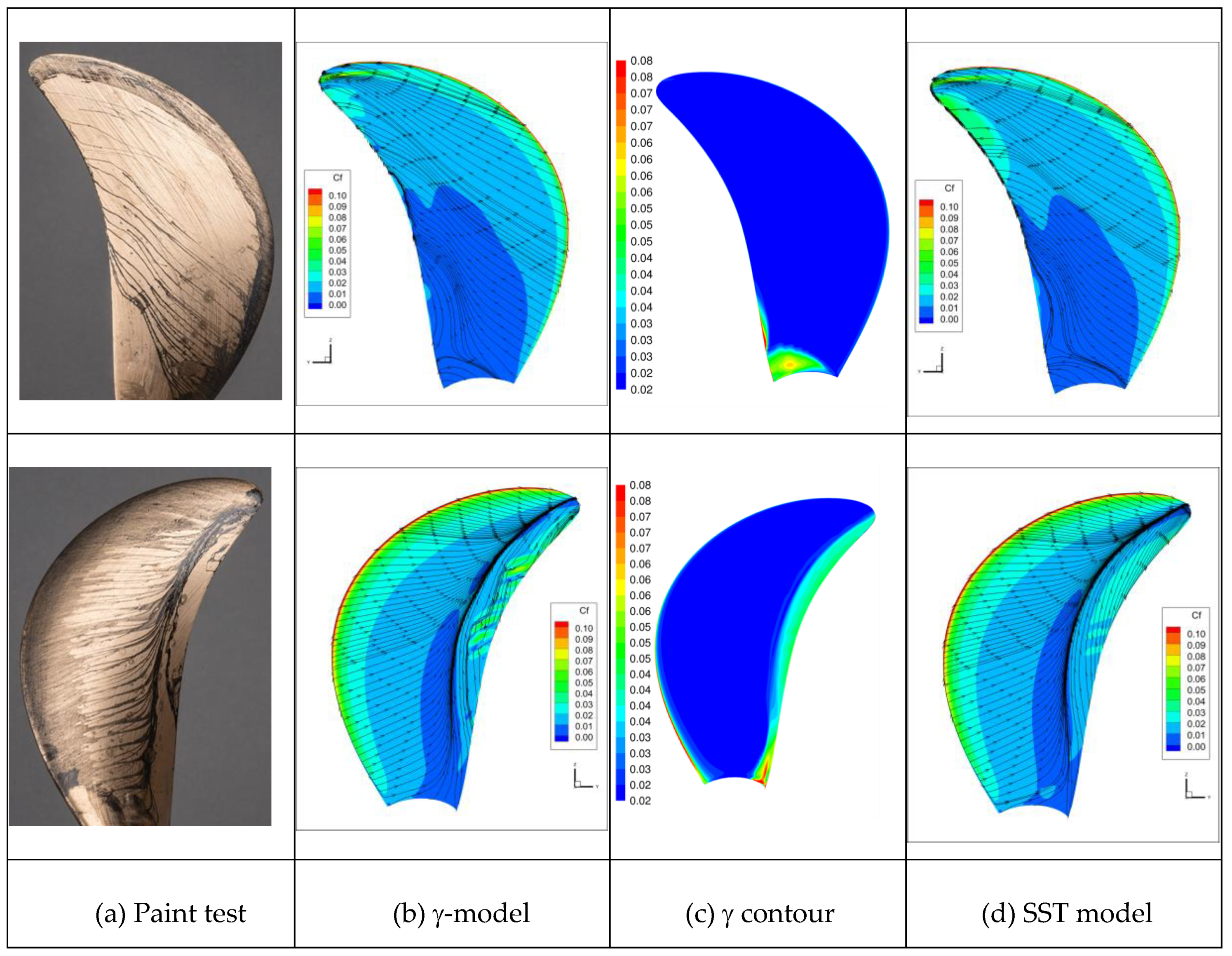
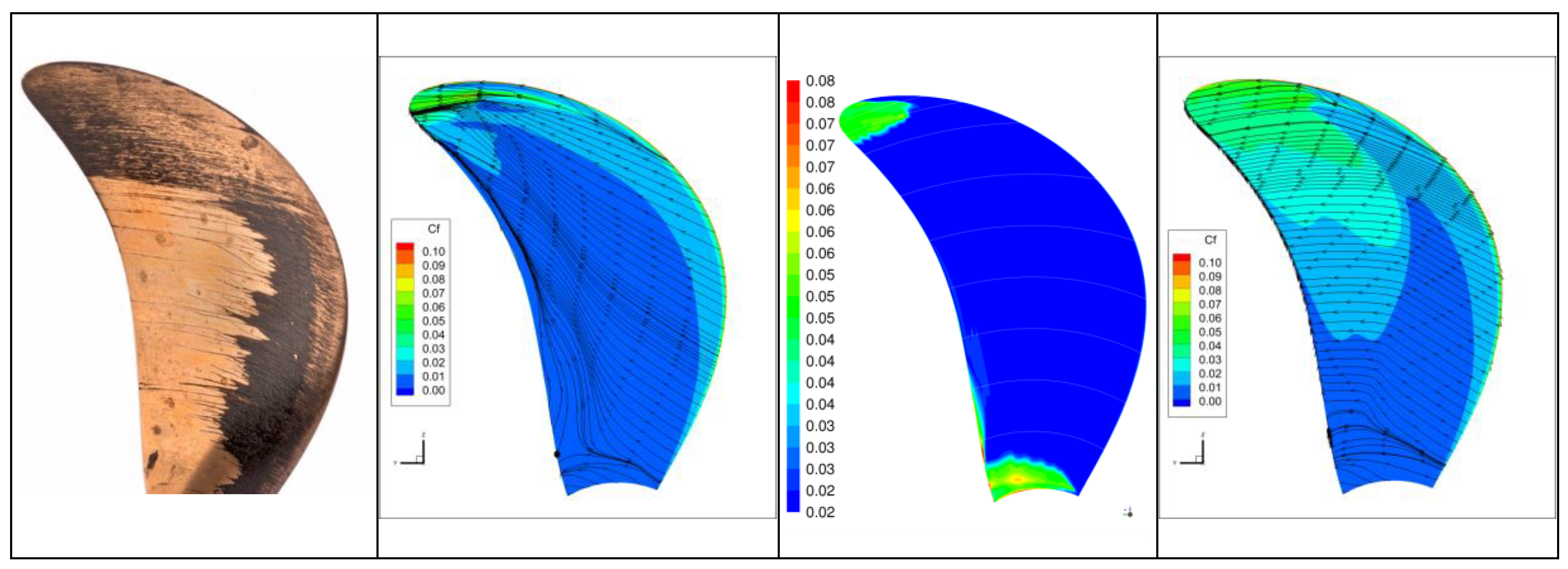

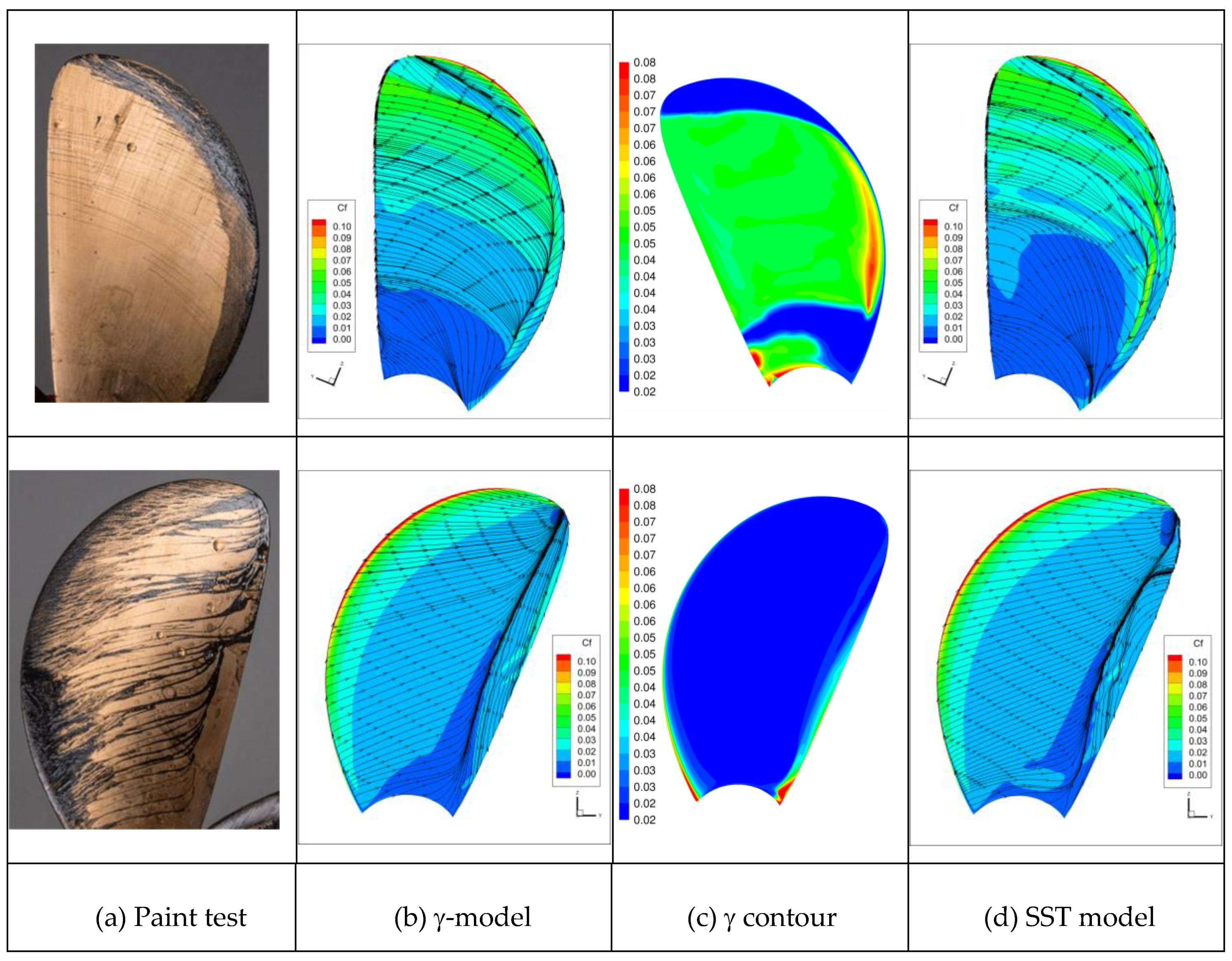
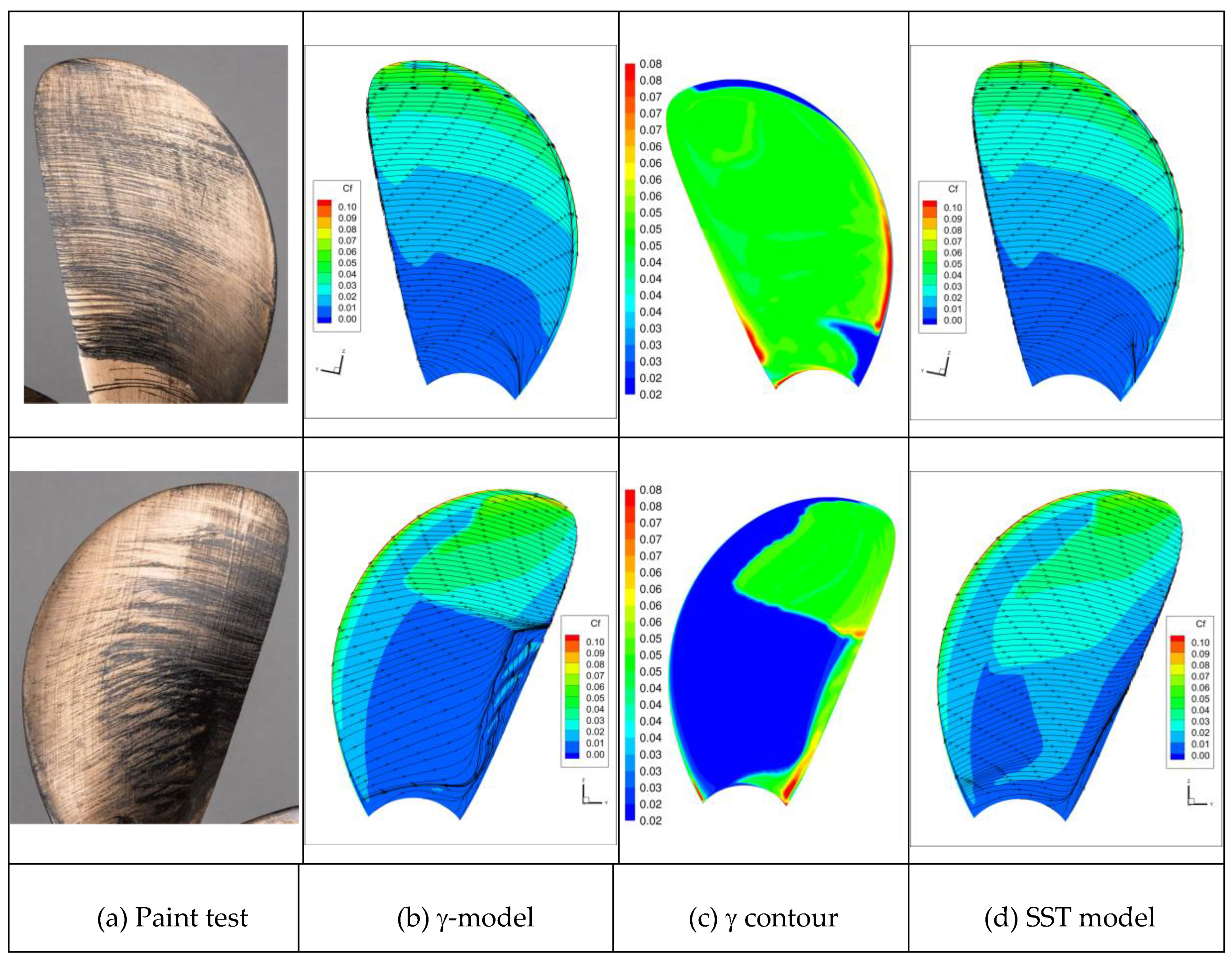
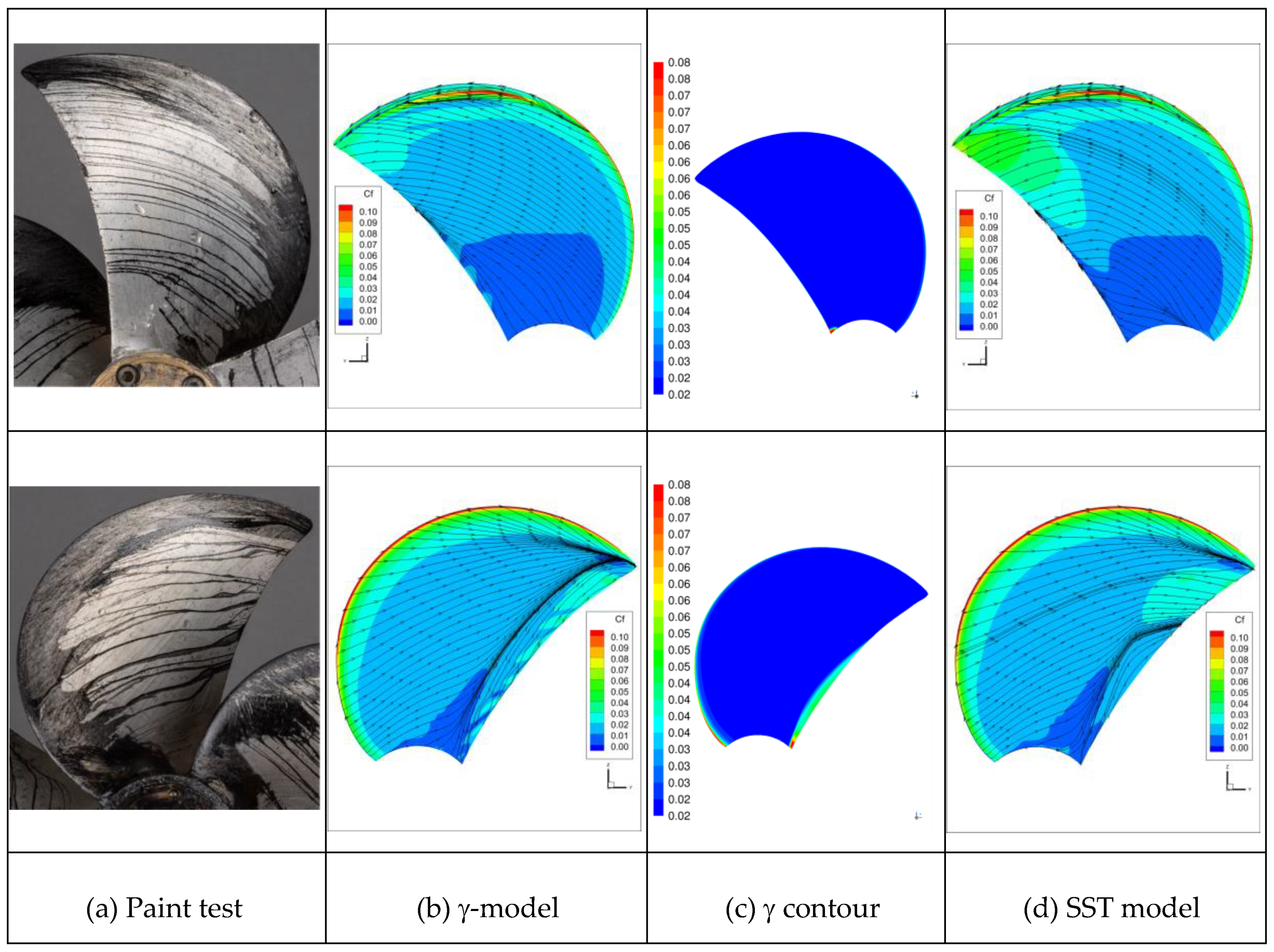
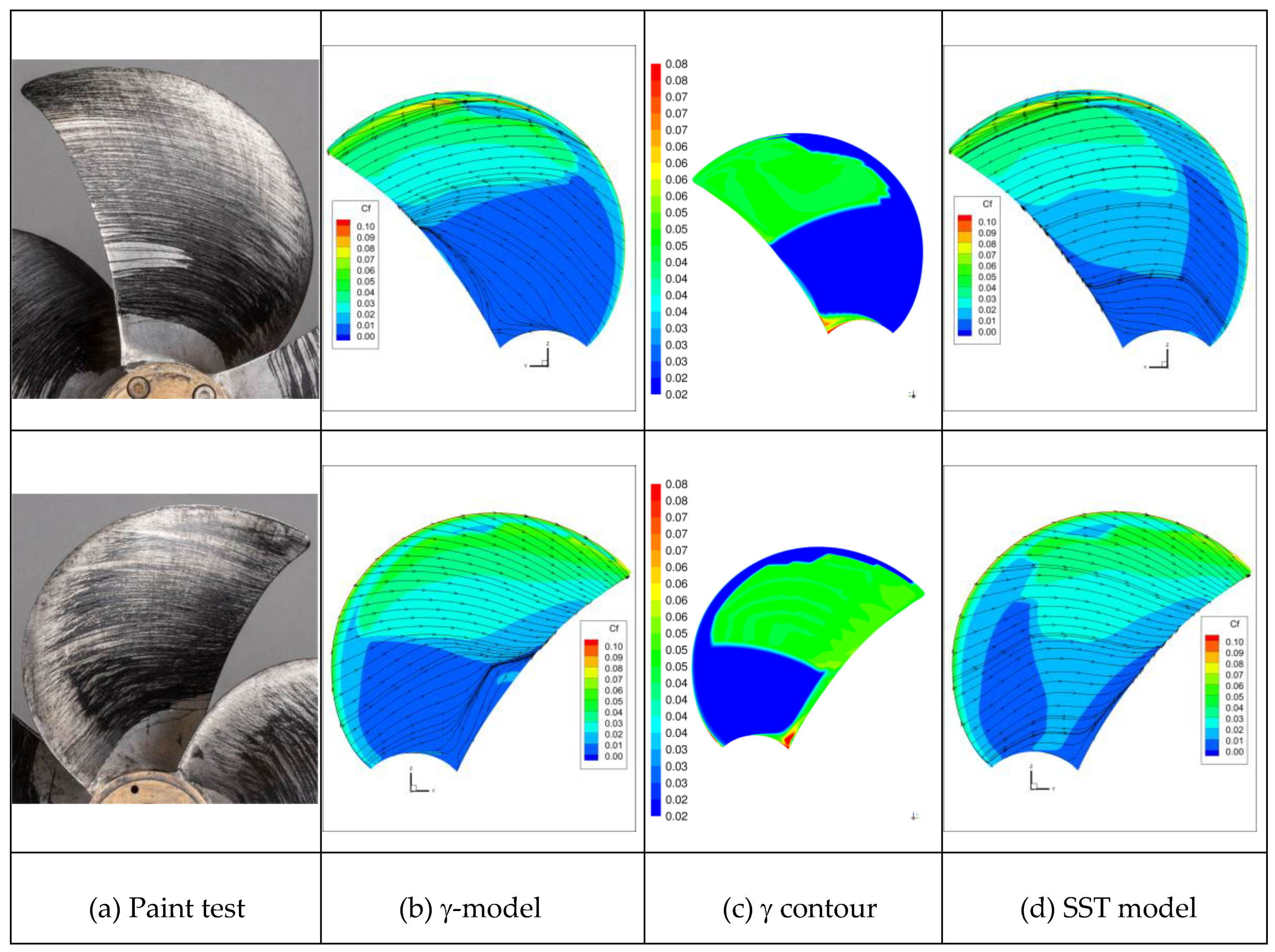
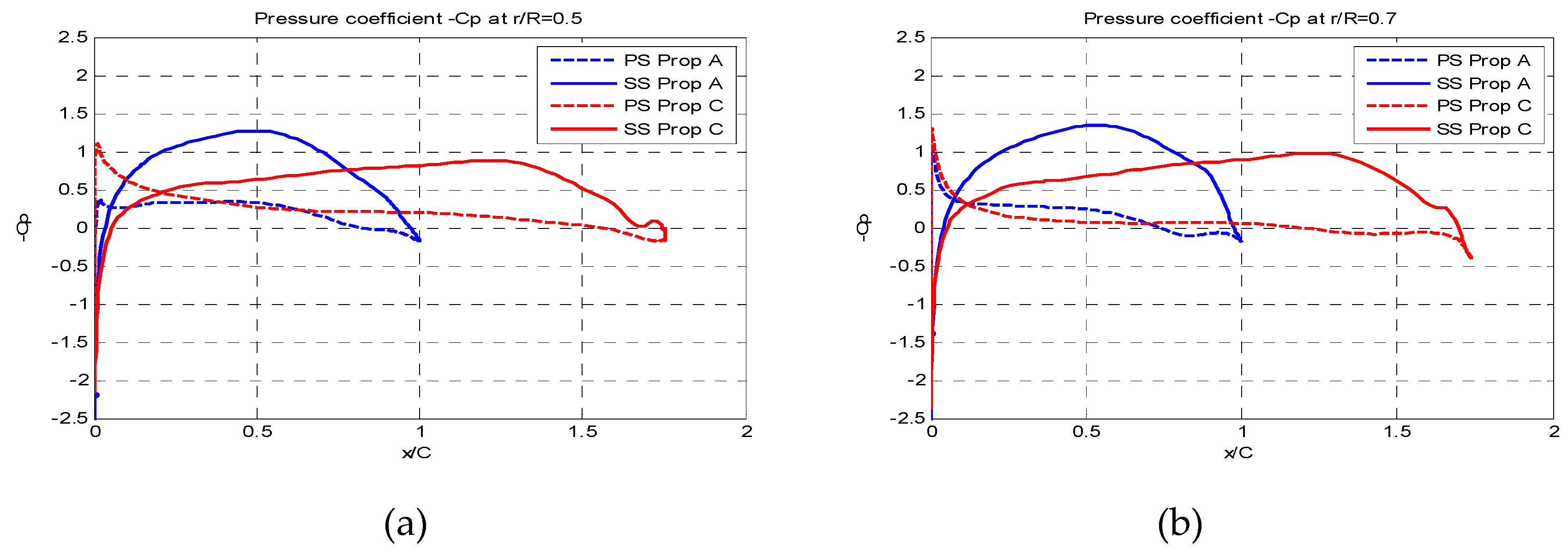
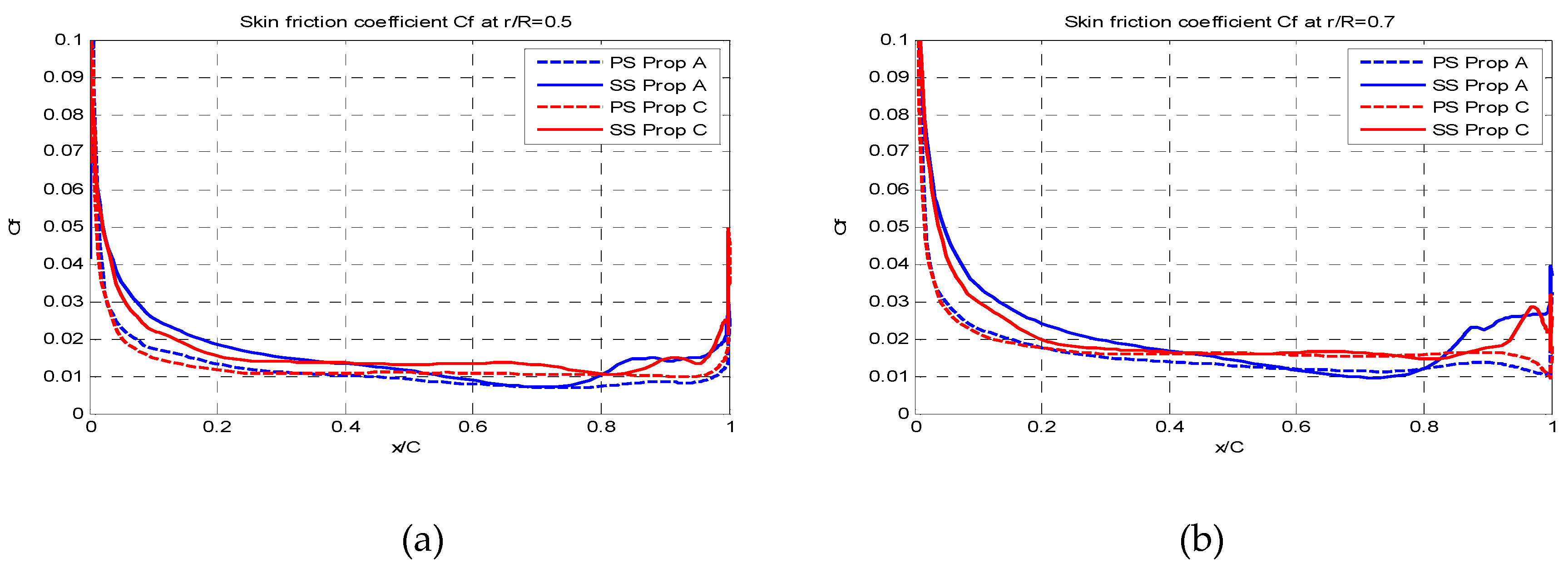
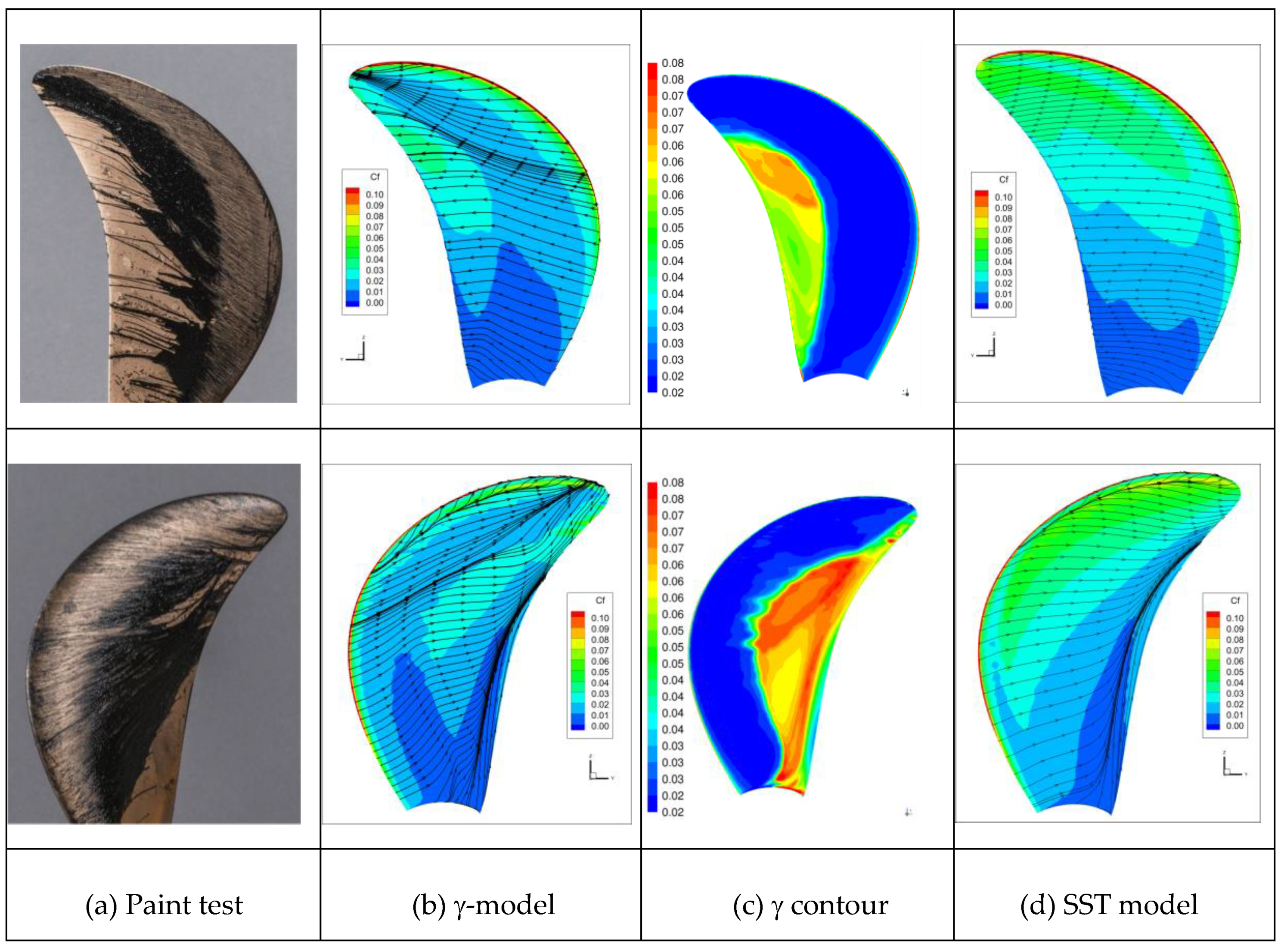
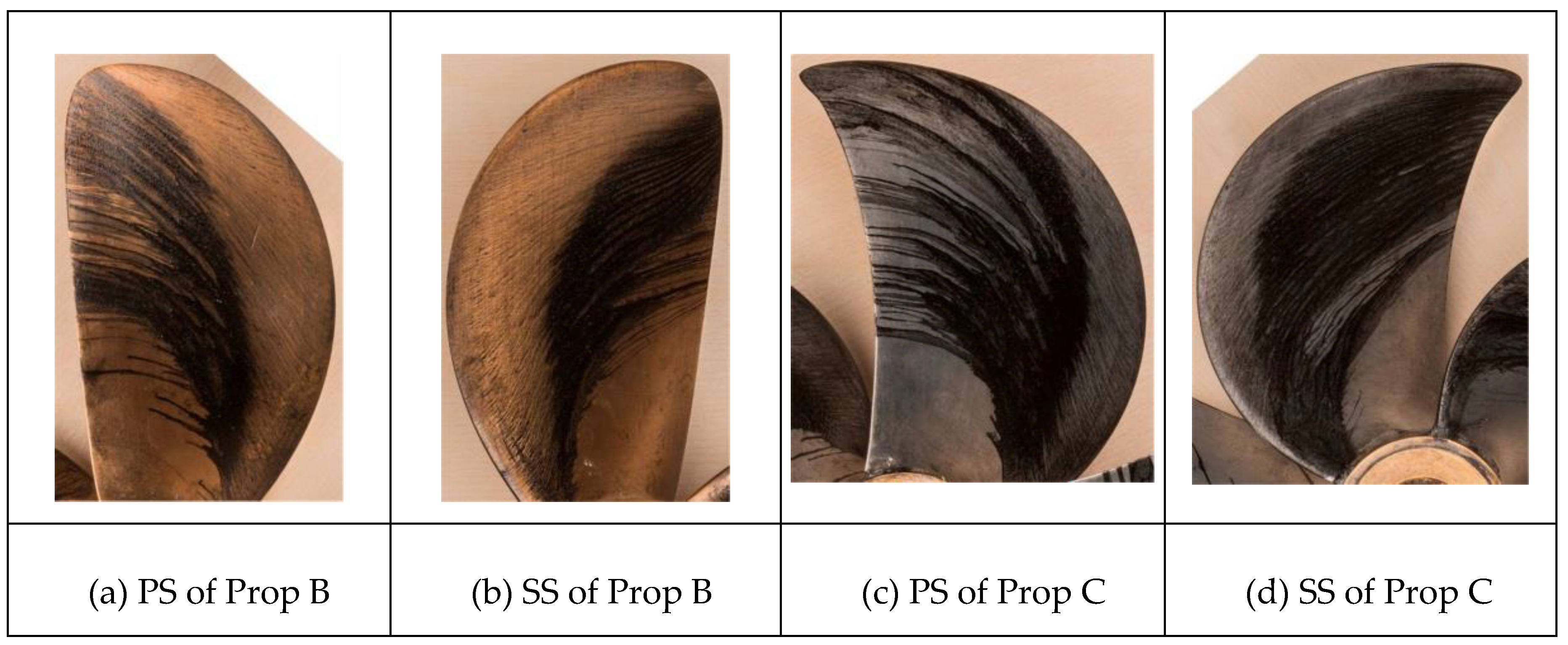
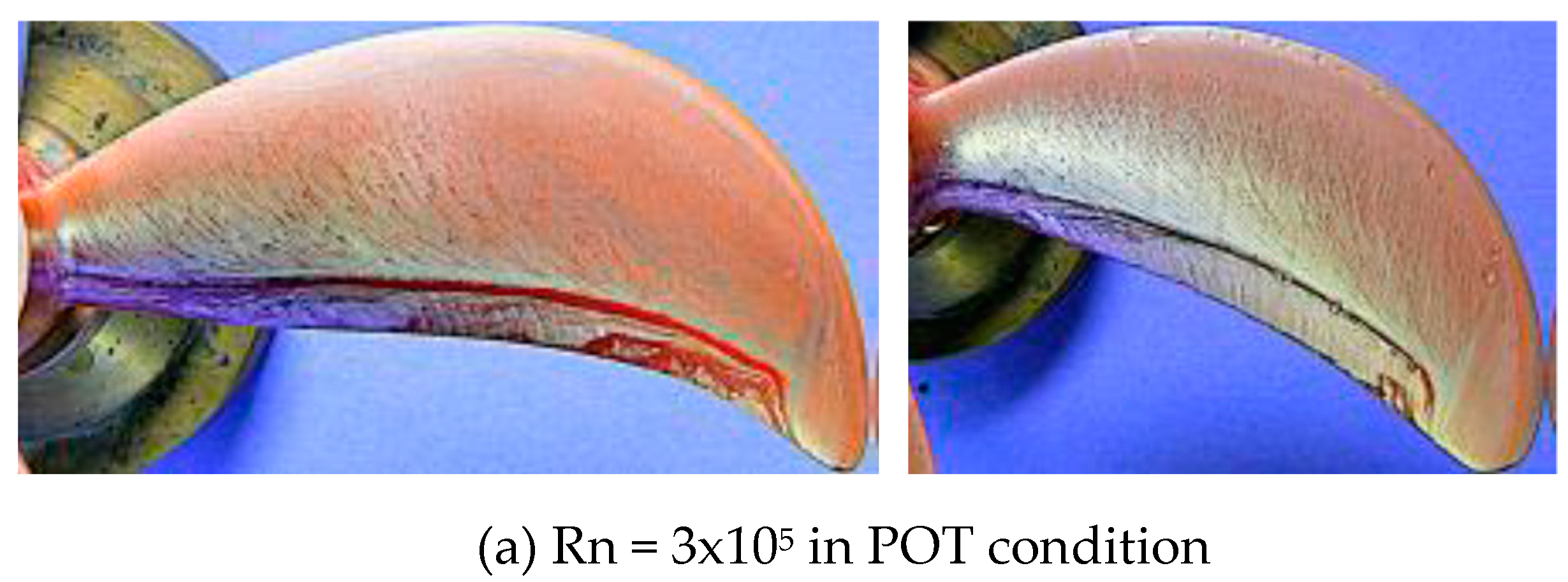
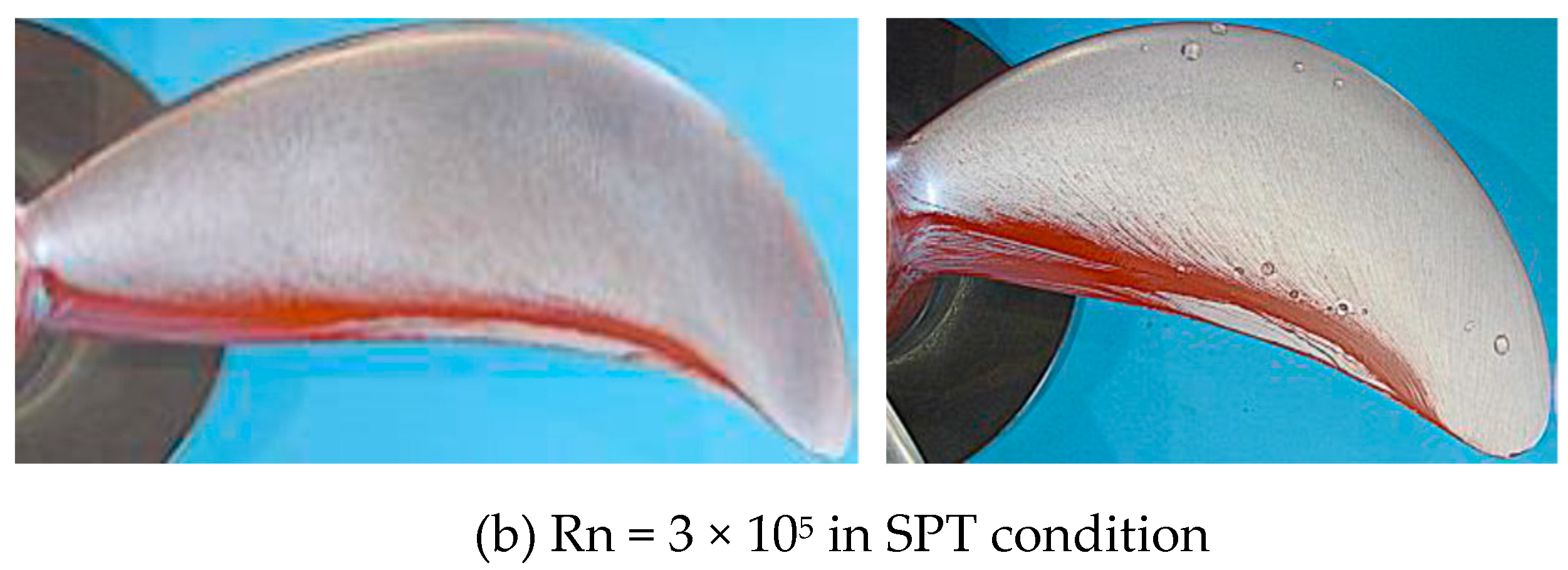
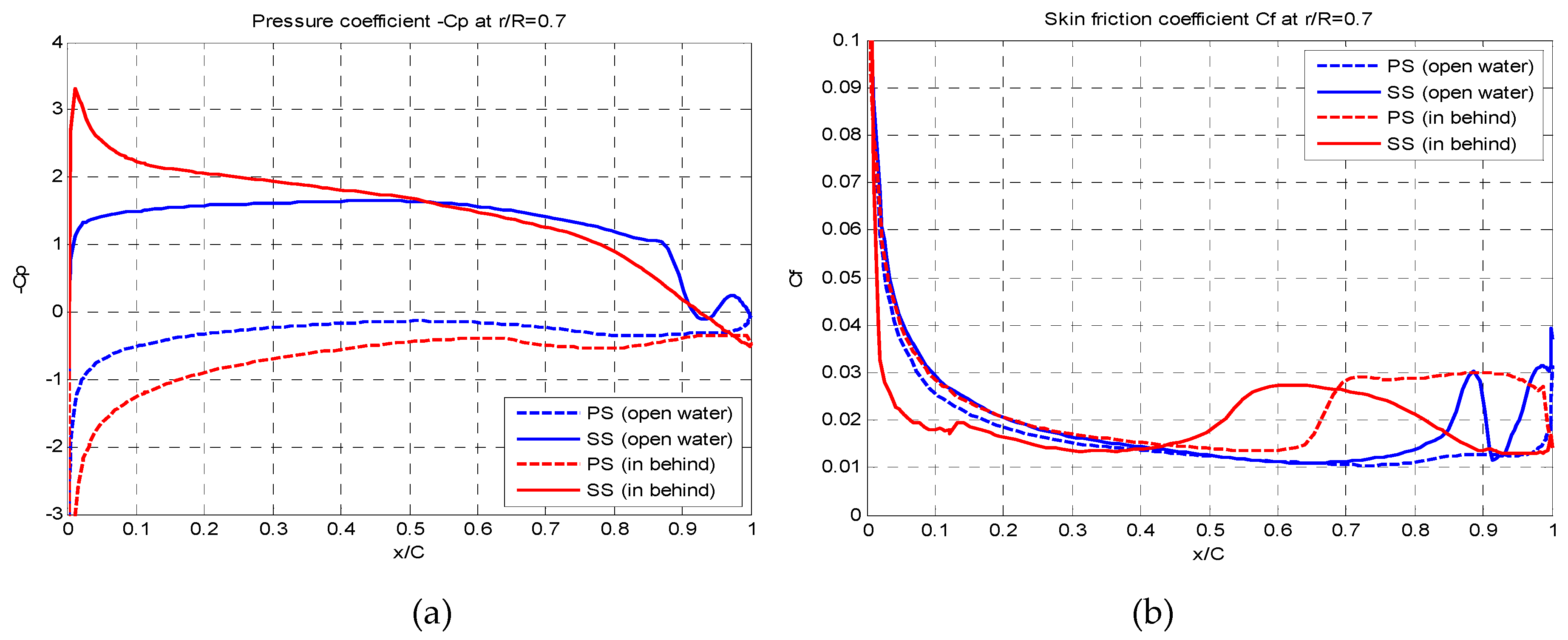
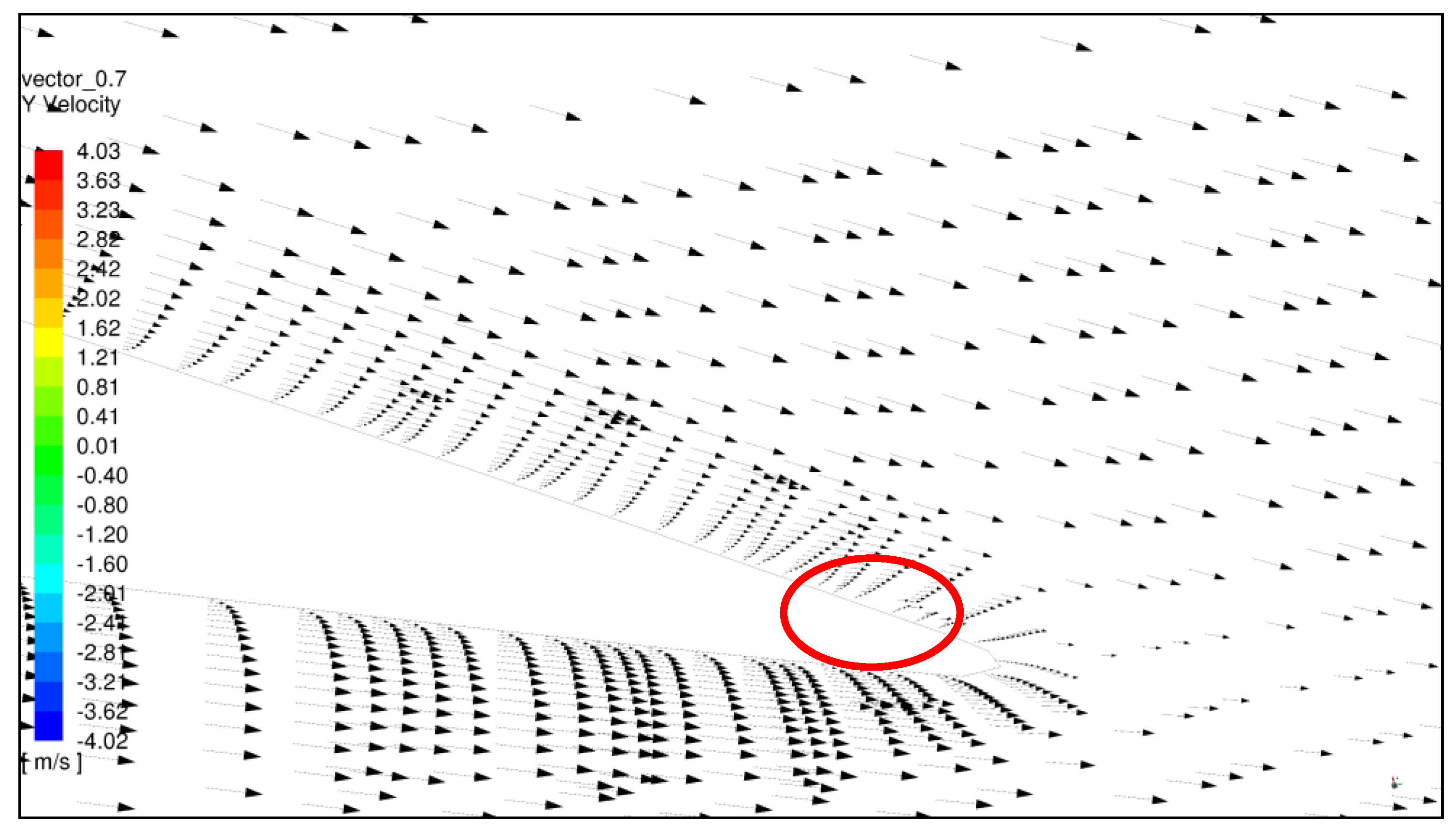
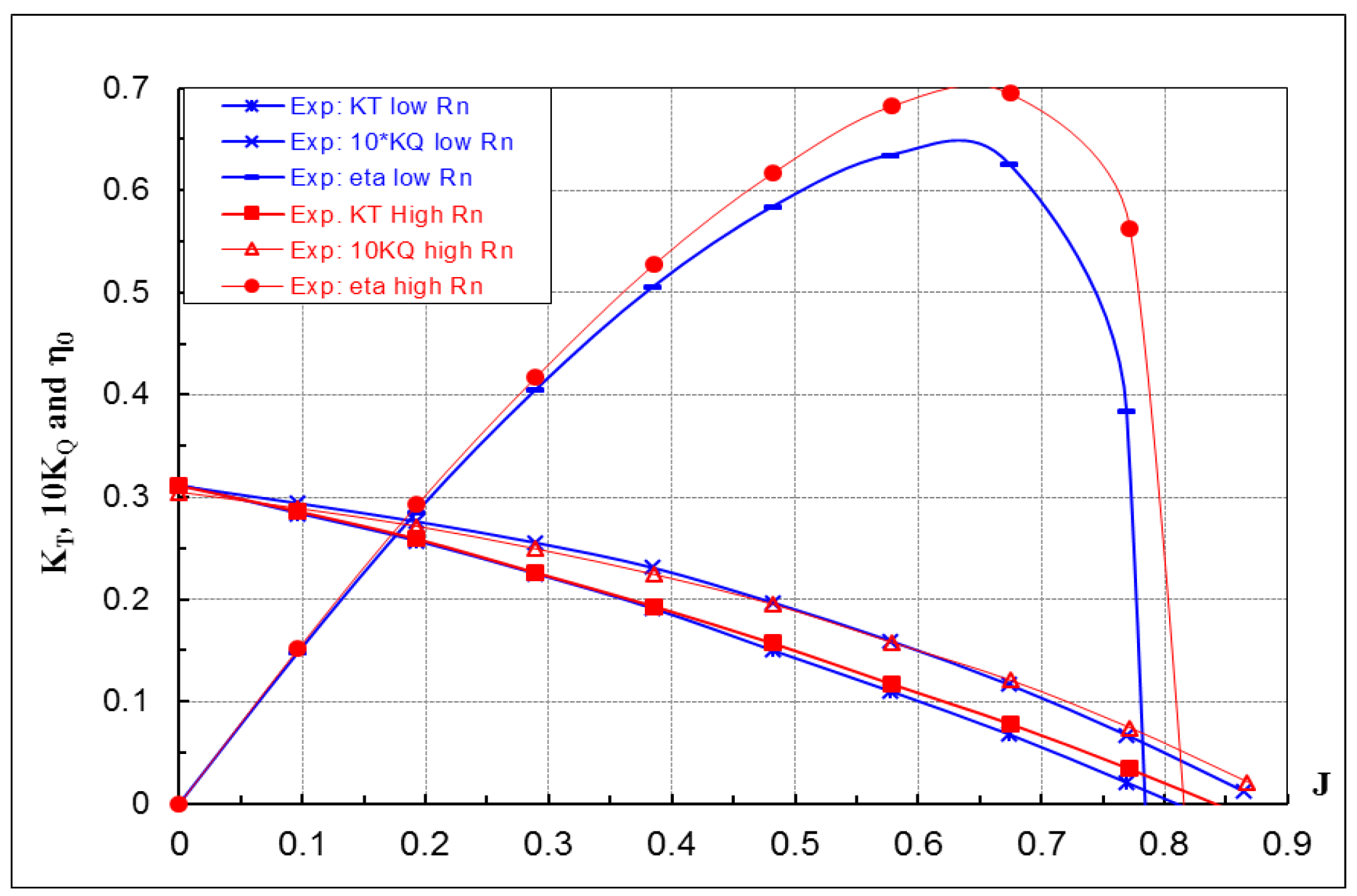
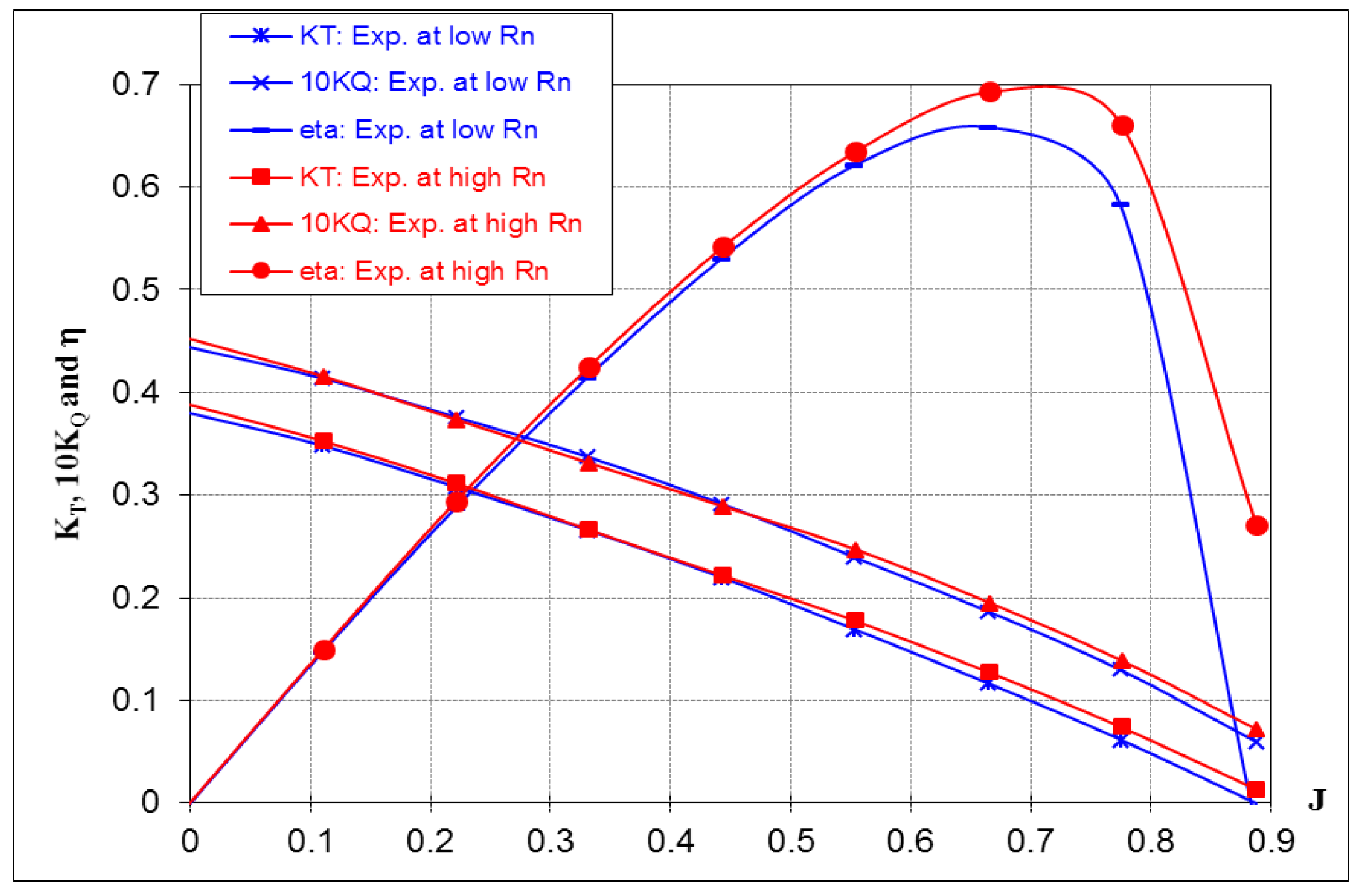
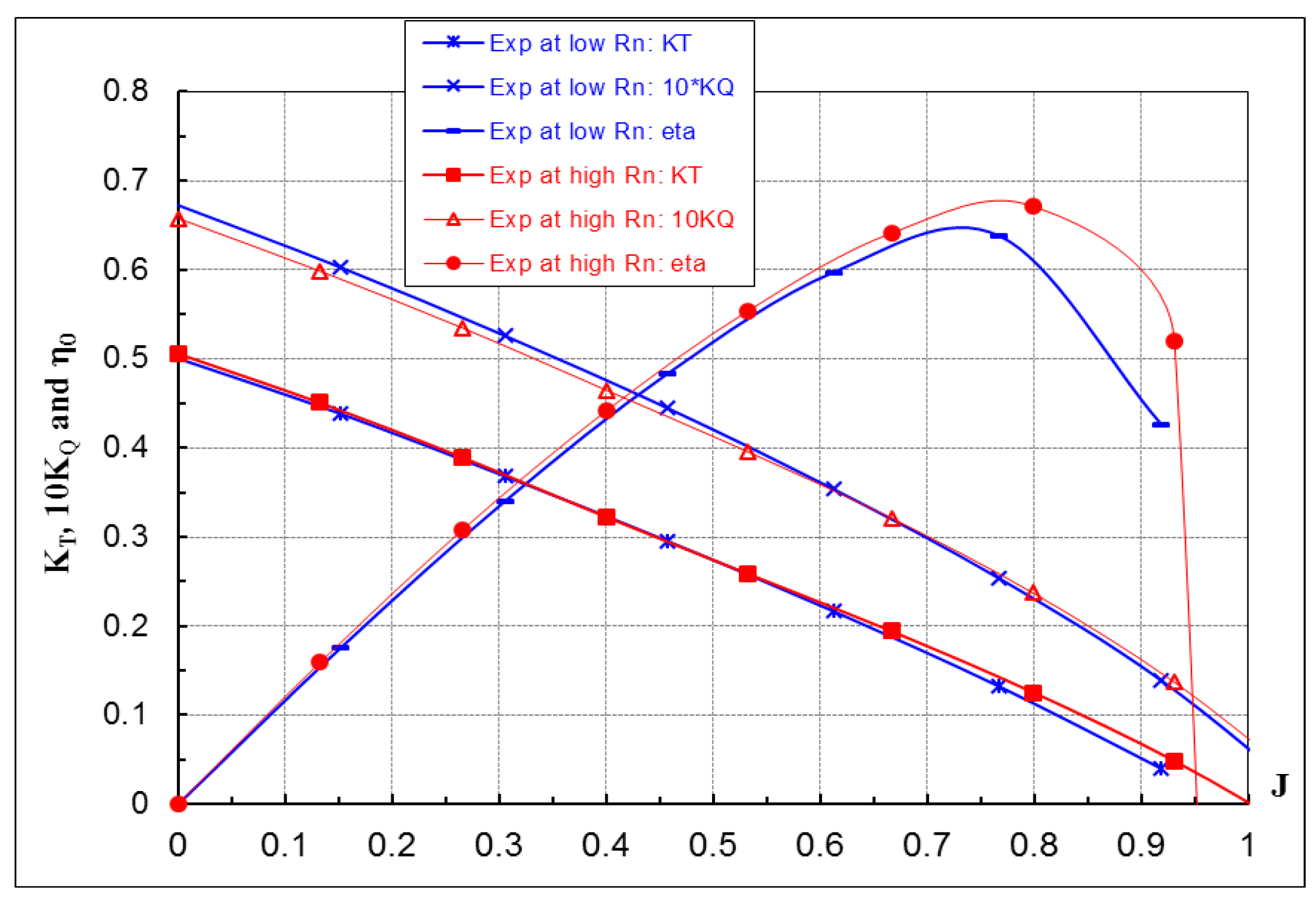
| Propeller | AE/A0/Z | P/D0.75R | tmax/C0.75R | C0.75R/D | Number of Blades |
|---|---|---|---|---|---|
| Prop A | 0.10 | - | - | - | - |
| Prop B | 0.13 | 0.83 | 0.0350 | 0.27 | 4 |
| Prop C | 0.16 | 1.00 | 0.0438 | 0.33 | 5 |
| Prop A | Prop B | Prop C | ||||
|---|---|---|---|---|---|---|
| Condition | Low Rn | High Rn | Low Rn | High Rn | Low Rn | High Rn |
| N [rps] | 8.1 | 20 | 6 | 18 | 5 | 15 |
| VA [m/s] | 1.214 | 3 | 1 | 3 | 1 | 3 |
| J [-] | 0.646 | 0.646 | 0.694 | 0.694 | 0.824 | 0.824 |
| Rn [x105] | 2.06 | 5.08 | 2.15 | 6.46 | 2.24 | 6.71 |
| Propeller | A | B | C | A (in behind) |
|---|---|---|---|---|
| Number of cells [million] | 5.028 | 3.840 | 4.091 | 8.193 |
| Prop | Rn [x105] | J | KT [-] | 10KQ [-] | ηo [-] | ΔKT [%] | ΔKQ [%] | Δηo [%] |
|---|---|---|---|---|---|---|---|---|
| A | 2.06 | 0.646 | 0.077 | 0.122 | 0.650 | −4.3 | −6.3 | 2.2 |
| 5.08 | 0.646 | 0.088 | 0.126 | 0.715 | −2.7 | −4.8 | 2.2 | |
| B | 2.15 | 0.694 | 0.098 | 0.169 | 0.642 | −4.5 | −2.4 | −2.2 |
| 6.46 | 0.694 | 0.109 | 0.179 | 0.671 | −3.6 | −1.4 | −2.2 | |
| C | 2.24 | 0.824 | 0.099 | 0.203 | 0.638 | 1.4 | −3.5 | 5.1 |
| 6.71 | 0.824 | 0.101 | 0.212 | 0.627 | −9.2 | −3.5 | 5.9 |
| Prop | Rn [x105] | J | KT [-] | 10KQ [-] | ηo [-] | ΔKT [%] | ΔKQ [%] | Δηo [%] |
|---|---|---|---|---|---|---|---|---|
| A | 2.06 | 0.646 | 0.072 | 0.115 | 0.641 | −10.4 | −11.3 | 1.0 |
| 5.08 | 0.646 | 0.081 | 0.122 | 0.682 | −9.8 | −7.5 | −2.5 | |
| B | 2.15 | 0.694 | 0.103 | 0.174 | 0.654 | 0.4 | 0.8 | −0.4 |
| 6.46 | 0.694 | 0.106 | 0.176 | 0.665 | −5.9 | −2.9 | −3.1 | |
| C | 2.24 | 0.824 | 0.097 | 0.203 | 0.629 | −0.3 | −3.6 | 3.5 |
| 6.71 | 0.824 | 0.098 | 0.206 | 0.626 | −12.0 | −6.3 | −6.0 |
| Prop | Case | Method | Vs [kn] | POT at | nm [1/s] | ηom [-] | ηR [-] | ηH [-] | Ship ηo [-] | Ship ηD [-] |
|---|---|---|---|---|---|---|---|---|---|---|
| A | 1a | ITTC-78 | 14.5 | high Rn | 8.1 | 0.540 | 0.991 | 1.170 | 0.614 | 0.711 |
| 1b | 2POT | 14.5 | low Rn | 8.1 | 0.508 | 1.029 | 1.180 | 0.610 | 0.741 | |
| B | 2 | ITTC-78 | 14 | high Rn | 6.6 | 0.575 | 1.022 | 1.224 | 0.631 | 0.790 |
| 3 | ITTC-78 | 14.5 | high Rn | 7.4 | 0.592 | 1.019 | 1.149 | 0.634 | 0.742 | |
| 4 | ITTC-78 | 15 | high Rn | 7.5 | 0.609 | 1.023 | 1.145 | 0.647 | 0.758 | |
| C | 5 | ITTC-78 | 24 | high Rn | 8.9 | 0.657 | 1.020 | 1.080 | 0.689 | 0.759 |
| 6 | ITTC-78 | 22 | high Rn | 9.6 | 0.614 | 1.021 | 1.119 | 0.648 | 0.740 |
© 2019 by the authors. Licensee MDPI, Basel, Switzerland. This article is an open access article distributed under the terms and conditions of the Creative Commons Attribution (CC BY) license (http://creativecommons.org/licenses/by/4.0/).
Share and Cite
Li, D.-Q.; Lindell, P.; Werner, S. Transitional Flow on Model Propellers and Their Influence on Relative Rotative Efficiency. J. Mar. Sci. Eng. 2019, 7, 427. https://doi.org/10.3390/jmse7120427
Li D-Q, Lindell P, Werner S. Transitional Flow on Model Propellers and Their Influence on Relative Rotative Efficiency. Journal of Marine Science and Engineering. 2019; 7(12):427. https://doi.org/10.3390/jmse7120427
Chicago/Turabian StyleLi, Da-Qing, Per Lindell, and Sofia Werner. 2019. "Transitional Flow on Model Propellers and Their Influence on Relative Rotative Efficiency" Journal of Marine Science and Engineering 7, no. 12: 427. https://doi.org/10.3390/jmse7120427
APA StyleLi, D.-Q., Lindell, P., & Werner, S. (2019). Transitional Flow on Model Propellers and Their Influence on Relative Rotative Efficiency. Journal of Marine Science and Engineering, 7(12), 427. https://doi.org/10.3390/jmse7120427




